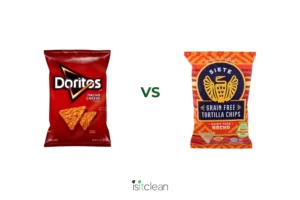There are better ways to raise chickens for eggs. Ways that are better for the planet and the people on this planet. Raising chickens in small flocks on pasture has been proven to lead to healthier eggs for people and have positive effects on our planet – from the soil to the ecosystem.
Companies using higher standards have started labeling eggs based on these standards.
The original intention was to create more transparency for consumers.
But, this also created an opportunity for the food industry to green wash their products and manipulate consumers into thinking they were buying eggs and meat that were humanely raised and healthier for them when in fact, they weren’t.
So as consumers, how do we navigate these ratings and claims?
We decided to organize the most popular labels and explain each one below so you can feel confident walking down the egg aisle, knowing that what you are buying is healthy for you and the planet.
USDA Certified Organic: This is one of the better labels. Chickens must have year round access to the outdoors. It also means that the animals are fed with only certified organic feed that is Non-GMO. Animals cannot be treated with hormones or antibiotics.
Pasture Raised: Compared to cage free and free range, this term is the best of the three in terms of quality of life for the chicken. This term means that the animal has spent at least some of its time on a pasture feeding on grass or foraging. There are no government standards on this label, meaning it’s not clear how much of the animal’s life is actually spent on pasture. While the USDA doesn’t regulate this term, third parties like Certified Humane certify brands using their standards (usually around 108 sq ft of pasture per hen).
Free Range: This term implies that chickens have access to the outside and adequate range to roam and engage in natural behavior. The problem is, the technical definition from the USDA is “the chicken or turkey has been allowed access to the outside.” This doesn’t define quality, size, or how long the chicken or turkey is allowed outside. It also doesn’t say that the chicken actually went outside, just has access. There are also no regular audits to verify this claim. This term also isn’t regulated by the USDA for egg producing chickens, only chickens produced for meat.
Cage Free: The term implies that chickens are not kept in a cage and since most chickens are kept in cages on industrial mega farms, this would be an improvement to standard living conditions. The problem is, “Cage-free” chickens are often stuffed in crowded indoor sheds with no space to walk or flap their wings. There is no legal definition of this term and there are no regular audits to verify there are no cages.
Standard Cage Eggs: You don’t see this term on egg products, but if you do not see cage free, free range, pasture raised, or USDA Organic then this means the chicken was raised in a cage on a factory farm with no access to the outdoors. Usually these cages stack hundreds of feet into the air and are a breeding ground for disease.
Fresh: The USDA only regulates this term on poultry meat, in that case it means that the meat wasn’t cooled below 26 degrees F. In all other categories (including eggs) there is no regulation for this term and companies can put it anywhere they way. It is a marketing ploy.
Natural or Naturally Raised: This term is virtually meaningless when it comes to eggs. The term natural is only regulated for meat products. With regards to eggs there is no regulation and is used as a marketing term to make consumers believe the eggs are of a certain quality.
___
Wholefoods’ unique rating system: Whole Foods Market has their own rating system they use for eggs that is in addition to the USDA ratings above. While this is a good step, we recommend taking these ratings with a grain of salt. These ratings are proprietary, meaning there is no third party oversight. The rating system is therefore coming from the same entity that has an invested interest in selling you more eggs. These ratings are helpful, but we’d recommend weighing the above labels such as USDA organic and Certified Humane Free Range or Pasture raised above the Whole Foods Market rating system. Here is a link to their website to see the full explanation of that rating system.
Conclusion:
USDA Organic is the best label to look for when it comes to eggs along with pasture raised.
In terms of the quality and standard of living for the chickens, the following terms go in this order from best quality of life to worst:
- Pasture Raised (look for third party certified)
- Free Range (Look for third party certified)
- Cage Free
- No term meaning they are standard caged eggs
The terms “Fresh” and “Natural” are virtually meaningless and are more marketing words.
The best case:
Buy local:
It’s best to buy eggs directly from a local farmer if available to you or look for local farms at farmers markets selling eggs. It is still important to ensure that these local farmers are using certified organic feed and allowing the hens outdoor access year round in large spaces.
If you are buying eggs at the store:
Find USDA Organic eggs that are Pasture Raised certified by a third party like Certified Humane or Animal Welfare Certified. It may still be possible to find local farms at your grocery store that meet this criteria.
Some examples of Certified Organic, Pasture Raised Certified brands are:
- Carol’s Eggs
- Utopihen Farms
- Vital Farms (note this company also sells pasture raised, non organic eggs. Look for the labels!)
- Happy Hens



